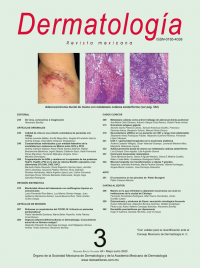Syphilitic secondary in a patient with HIV and undetectable viral load.
Dermatol Rev Mex. 2020 mayo-junio;64(3):318-320.
Stephanie Anely Rodríguez-Fabián,1 Alejandra Guerrero-Álvarez,2 Fernando López-Vázquez3
1 Residente de tercer año de Dermatología.
2 Residente de primer año de Dermatología.
3 Médico adscrito al Servicio de Dermatología.
Hospital Regional Licenciado Adolfo López Mateos, ISSSTE, Ciudad de México.
Resumen
ANTECEDENTES: La sífilis es un problema de salud pública en todo el mundo; actualmente y con el aumento de VIH, ha habido emergencia de la infección por sífilis y esto altera su historia natural y sus manifestaciones, lo que causa que los casos de secundarismo sifilítico sean más frecuentes actualmente.
CASO CLÍNICO: Paciente masculino de 51 años, que acudió a consulta por padecer una dermatosis pruriginosa de una semana de evolución; diseminada, con tendencia a la generalización, que no afectaba las plantas; estaba constituida por múltiples máculas y pápulas no foliculares, milimétricas, eritematoescamosas; en los testículos, el escroto y la región anal tenía múltiples neoformaciones aplanadas del color de la piel que se asociaban formando placas de mayor tamaño, de bordes bien definidos. El paciente tenía el antecedente de infección por VIH de 10 años de evolución en tratamiento actual con efavirenz/tenofovir/emtricitabina. Refirió una lesión aftosa en el labio dos semanas previas al inicio de la dermatosis. Con la sospecha clínica de roséola sifilítica y condiloma lata, se solicitó VDRL que fue positivo y se indicó tratamiento con penicilina benzatínica.
CONCLUSIONES: La penicilina benzatínica sigue siendo el tratamiento patrón de referencia de todas las etapas de la sífilis. Los pacientes con secundarismo sifilítico y VIH positivo deben tratarse de la misma manera que los pacientes VIH negativo.
PALABRAS CLAVE: Sífilis; infección por VIH.
Abstract
BACKGROUND: Syphilis is a public health problem worldwide; currently and with the increase of HIV, there has been an emergency of the infection by syphilis and this alters its natural history and manifestations, making more frequent cases of syphilitic secondaryism.
CLINICAL CASE: A 51-year-old male patient, who came to the clinic for suffering from itchy dermatosis lasting one week; disseminated, with a tendency to generalization, which did not affect the plants; it consisted of multiple macules and non-follicular papules, millimetric, erythematous, squamous; in the testes, scrotum and anal region had multiple flattened skin-colored neoformations that were associated to form larger plates with well-defined edges. The patient had a 10-year history of HIV infection in current treatment with efavirenz/tenofovir/emtricitabine. He reported an aphthous lesion on the lip two weeks prior to the onset of dermatosis. With clinical suspicion of syphilitic roseola and condyloma lata, a VDRL was requested being positive and treatment with benzathine penicillin was indicated.
CONCLUSIONS: Benzathine penicillin remains the gold standard treatment for all stages of syphilis. Patients with syphilitic secondary and HIV positive should be treated in the same way as HIV negative patients.
KEYWORDS: Syphilis; HIV infection.

